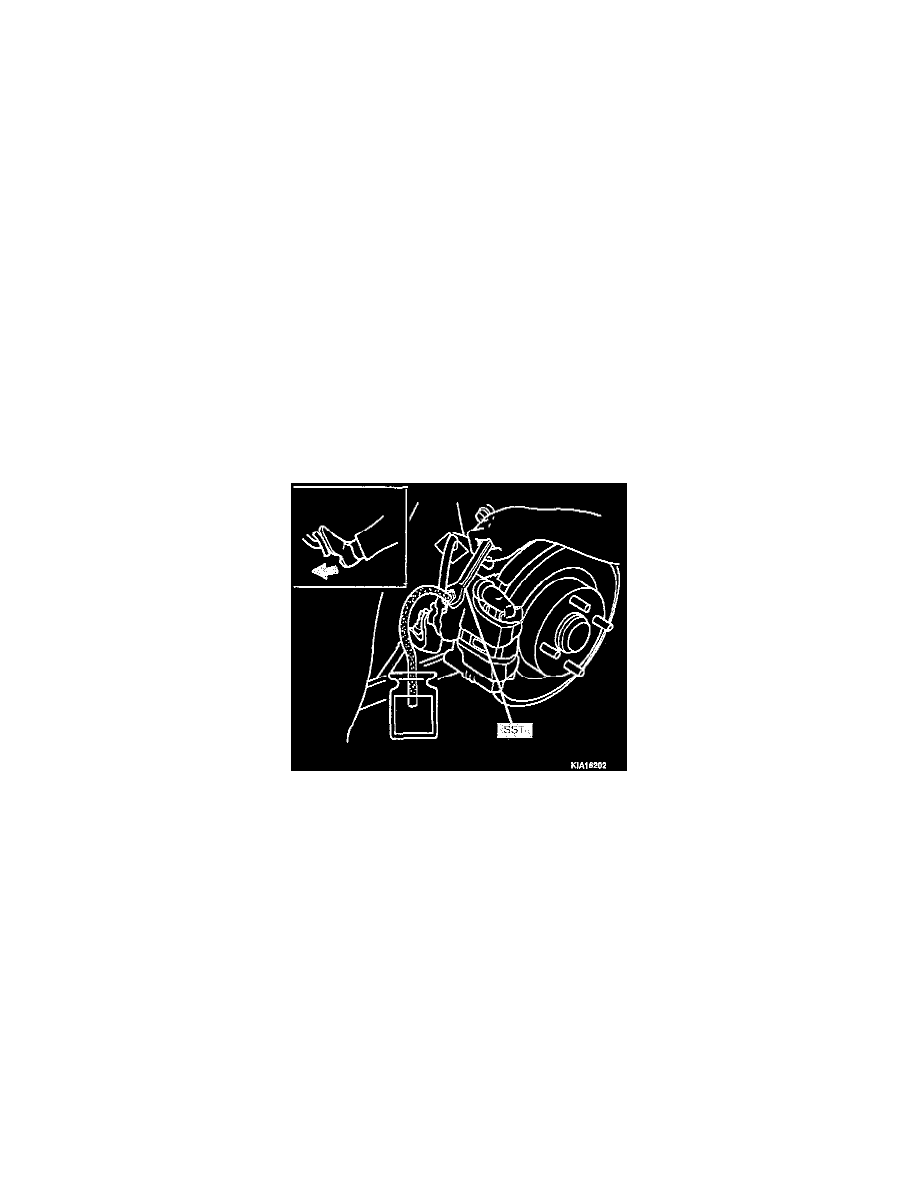Sephia GS Sedan L4-1.8L (1997)

Brake Bleeding: Service and Repair
Brake System Bleeding Procedures
Pressure
WARNING:
-
THE PUMP IN THE ABS, WHEN OPERATING, PRODUCES HIGH BRAKE FLUID PRESSURE THROUGHOUT THE BRAKE
SYSTEM. IT IS IMPORTANT THAT ALL FLUID CONNECTORS BE SECURE BEFORE ALLOWING THE PUMP MOTOR TO
OPERATE. THIS PRESSURE SUBSIDES QUICKLY WHEN THE PUMP MOTOR SHUTS OFF AND IS OF NO CONCERN DURING
MOST ABS SERVICING. BE CAUTIOUS, HOWEVER, WHEN BREAKING A FLUID CONNECTION IMMEDIATELY AFTER THE
PUMP MOTOR HAS OPERATED. RESIDUAL PRESSURE MAY BE PRESENT.
-
BRAKE FLUID CONTAINS POLYALKALENE GLYCOL ETHERS. AVOID CONTACT WITH EYES. WASH HANDS
THOROUGHLY AFTER HANDLING. IF BRAKE FLUID CONTACTS EYES, FLUSH WITH RUNNING WATER FOR 15
MINUTES. GET MEDICAL ATTENTION IF IRRITATION PERSISTS. IF TAKEN INTERNALLY, DRINK WATER AND INDUCE
VOMITING. GET MEDICAL ATTENTION IMMEDIATELY.
CAUTION:
-
When any part of the hydraulic brake system has been disconnected for repair or replacement, air may get into the lines and cause spongy, unsafe
pedal action. This requires the bleeding of the brake system to ensure that all air is expelled from the brake cylinders and lines. The brake system
can be bled manually or with pressure-bleeding equipment, such as a brake bleeder. Pressure bleeding is the preferred method.
-
Bleed one wheel at a time. Start the bleeding at the right rear wheel and then the left rear wheel. Proceed to bleed the front brakes, starting with the
right front brake. Finish bleeding at the left front brake. Keep the master cylinder reservoir filled with SAE J1703 DOT 3 or DOT 4 brake fluid.
-
Never reuse brake fluid that has been drained from the system.
-
Be sure the bleeder tank holds enough specified brake fluid to complete the bleeding operation. Charge the tank with approximately 10 - 30 psi
(69 - 206 kPa) of air. Never exceed 50 psi (345 kPa) of pressure.
1. Clean all dirt from the master cylinder reservoir cap and top of the reservoir.
2. Remove the master cylinder reservoir cap and fill the master cylinder reservoir with the specified brake fluid. Connect the pressure adapter to the
master cylinder.
NOTE: Master cylinder pressure bleeder adapter tools are available from various manufacturers of pressure-bleeding equipment. Follow the
instructions of the manufacturer when installing the adapter.
3. Ensure proper torque at each outlet port of the master cylinder before beginning any pressure bleeding. During pressure bleeding, observe all
joints/connections for leakage. Repair as necessary.
4. Place a box wrench on the bleeder fitting at the right rear brake wheel cylinder. Attach a rubber drain tube to the bleeder fitting, making sure the
end of the tube fits snugly around the bleeder fitting. Submerge the free end of the tube in a container partially filled with clean brake fluid.
5. Open the valve on the bleeder tank to admit pressurized fluid into the master cylinder reservoir.
6. Loosen the bleeder fitting at the wheel cylinder.
7. When air bubbles no longer appear in the fluid at the submerged end of the bleeder tube, close the bleeder fitting and remove the bleeder tube.
8. Repeat steps 4 through 7 for the remaining wheels.
9. When the bleeding operation is completed, close the bleeder tank valve and remove the tank hose from the adapter fitting.
10. Remove the pressure bleeder adaptor tool. Fill the master cylinder to the MAX level line on the master cylinder reservoir. Install the master
cylinder reservoir cap and clean any spilled fluid. Wipe off any brake fluid that contacts a painted surface immediately.
Manual
WARNING:
